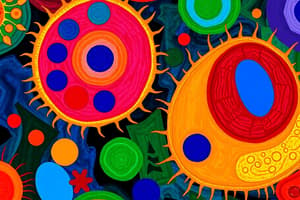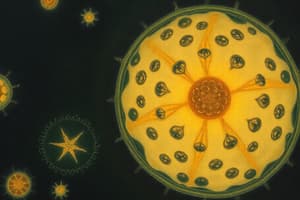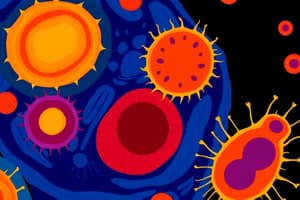Podcast
Questions and Answers
Who first used the term 'cell' in biology?
Who first used the term 'cell' in biology?
- Rudolf Virchow
- Anton van Leeuwenhoek
- Louis Pasteur
- Robert Hooke (correct)
Which of the following statements about all cells is true?
Which of the following statements about all cells is true?
- All cells have a nucleus
- All cells are large and complex
- All cells are prokaryotic
- All cells can reproduce (correct)
What primary function does the cell membrane serve?
What primary function does the cell membrane serve?
- Physical boundary and communication (correct)
- Nutrient production
- Waste elimination
- Gene expression
What does the cell theory state?
What does the cell theory state?
How do the size and complexity of prokaryotic cells compare to eukaryotic cells?
How do the size and complexity of prokaryotic cells compare to eukaryotic cells?
Which component is not part of the nucleus?
Which component is not part of the nucleus?
What is the primary role of ribosomes in the cell?
What is the primary role of ribosomes in the cell?
Which function is NOT performed by cells?
Which function is NOT performed by cells?
Which structure is absent in unicellular organisms?
Which structure is absent in unicellular organisms?
What type of cell has a membrane-bound nucleus?
What type of cell has a membrane-bound nucleus?
What structure is responsible for the sorting and modification of molecules in the cell?
What structure is responsible for the sorting and modification of molecules in the cell?
Which part of the endoplasmic reticulum is involved in protein synthesis?
Which part of the endoplasmic reticulum is involved in protein synthesis?
What is a key difference in ribosomes between unicellular and multicellular organisms?
What is a key difference in ribosomes between unicellular and multicellular organisms?
Which shape is characteristic of red blood cells?
Which shape is characteristic of red blood cells?
Where does transcription occur in unicellular organisms?
Where does transcription occur in unicellular organisms?
What is a key characteristic of nerve cells?
What is a key characteristic of nerve cells?
What is the jellylike substance that fills the cell and is responsible for nutrient distribution?
What is the jellylike substance that fills the cell and is responsible for nutrient distribution?
Which of the following statements about prokaryotes is true?
Which of the following statements about prokaryotes is true?
Which of the following organelles is present in multicellular organisms but absent in unicellular organisms?
Which of the following organelles is present in multicellular organisms but absent in unicellular organisms?
Which type of cell has a simpler cell wall compared to the other?
Which type of cell has a simpler cell wall compared to the other?
What is the primary component of the nuclear envelope?
What is the primary component of the nuclear envelope?
Which of the following structures is present in both unicellular and multicellular organisms?
Which of the following structures is present in both unicellular and multicellular organisms?
What distinguishes multicellular organisms from unicellular organisms in terms of size?
What distinguishes multicellular organisms from unicellular organisms in terms of size?
What is the primary purpose of cell division in multicellular organisms?
What is the primary purpose of cell division in multicellular organisms?
Which phase of the cell cycle involves the duplication of DNA?
Which phase of the cell cycle involves the duplication of DNA?
What is the outcome of mitosis?
What is the outcome of mitosis?
What characterizes binary fission in prokaryotic cells?
What characterizes binary fission in prokaryotic cells?
In which stage of the cell cycle does the cell undergo its primary growth phase?
In which stage of the cell cycle does the cell undergo its primary growth phase?
Which of the following statements about cell division is accurate?
Which of the following statements about cell division is accurate?
During which phase do cells prepare for division and conduct a check on replicated DNA?
During which phase do cells prepare for division and conduct a check on replicated DNA?
What is the main feature of the M-phase in the cell cycle?
What is the main feature of the M-phase in the cell cycle?
What is the primary function of the Golgi apparatus?
What is the primary function of the Golgi apparatus?
What is produced by the mitochondria?
What is produced by the mitochondria?
What is a key function of lysosomes?
What is a key function of lysosomes?
What do chloroplasts use to synthesize food?
What do chloroplasts use to synthesize food?
How do chloroplasts and mitochondria differ largely in function?
How do chloroplasts and mitochondria differ largely in function?
What is glycogen specifically used for in animal cells?
What is glycogen specifically used for in animal cells?
Which of the following best describes vesicles?
Which of the following best describes vesicles?
What characteristic differentiates plant cells from animal cells?
What characteristic differentiates plant cells from animal cells?
Flashcards are hidden until you start studying
Study Notes
Unicellular vs. Multicellular
- Unicellular organisms lack lysosomes, peroxisomes, microtubules, endoplasmic reticulum, mitochondria, and a cytoskeleton
- Unicellular organisms have smaller ribosomes
- Multicellular organisms have lysosomes, peroxisomes, microtubules, endoplasmic reticulum, mitochondria, and a cytoskeleton
- Multicellular organisms have larger ribosomes
Organelles
- Organelles are biological structures that perform specific functions inside a cell
- The cell membrane is the physical boundary between the inside of the cell (intracellular) and its outside (extracellular)
- It's composed of lipids, proteins, and carbohydrates
- It's semi-permeable, provides protection, and facilitates cell communication
- The cytoplasm is a jellylike fluid that fills the space between the plasma membrane and the nuclear membrane.
- It contains cytosol (water, salts, organic molecules, and proteins) and cellular organelles (except for the nucleus)
- It helps with cell growth and distributes nutrients
- The nucleus isolates the genetic material (DNA) from the rest of the cell.
- It is the largest organelle in the cell
- It contains the nuclear envelope (two lipid bilayers separating the nucleus from the cytoplasm), nuclear pores, chromatin (DNA or RNA and proteins), and the nucleolus (genes for ribosomal RNA)
- Ribosomes are intercellular structures made of rRNA and protein.
- They are found in the cytosol or attached to the endoplasmic reticulum
- They consist of two subunits: large and small
- They produce protein
- The endoplasmic reticulum (ER) is a system of membranous channels and a network that serves as the internal production and delivery system of the cell.
- Rough ER (with ribosomes) is the site of protein synthesis
- Smooth ER (without ribosomes) is the site of phospholipid synthesis
- The Golgi apparatus is a stack of curved saccules that receives molecules, changes them, and sorts them for transport to different cell parts.
- It's like a cell post office
- It receives protein and lipid-filled vesicles from the ER, packages, modifies, and distributes them within or outside the cell (protein secretion)
- It plays a role in post-translational modification (glycosylation)
- Mitochondria are double membrane-bound organelles that produce large amounts of energy in the form of ATP, earning them the title of "powerhouse of the cell."
- They promote the growth of new cells.
- They synthesize ATP, which serves as the "energy currency" of the cell.
- Vesicles are small compartments separated from the cytosol by at least one lipid bilayer that store, transport, or digest cellular products and waste.
- Lysosomes are membrane-bound cell vesicles containing hydrolytic enzymes that break down food into small particles, destroy old cellular components, and participate in phagocytosis to protect cells from pathogens.
- The chloroplast is a plastid found in plants and blue-green algae that is responsible for photosynthesis.
- It contains chlorophyll (a green pigment that absorbs solar energy)
- It contains its own DNA and some ribosomes
- It synthesizes food using solar energy through photosynthesis.
- Chloroplasts absorb energy from sunlight and store it in sugars (photosynthesis)
- Mitochondria use chemical energy stored in sugars as fuels to generate ATP (cellular respiration)
Plant vs. Animal Cells
- Plant cells have chloroplasts
- Animal cells don't have chloroplasts
- Plant cells have cell walls
- Animal cells don't have cell walls
- Plant cells have a large central vacuole
- Animal cells have smaller vacuoles
- Plant cells store carbohydrates as starch
- Animal cells store carbohydrates as glycogen
Reproduction and Cell Division
- Cell division is a biological process where a parent cell duplicates its contents and divides into two or more daughter cells.
- It's essential for growth, repair, and reproduction in multicellular organisms.
- It's the sole source of reproduction in unicellular organisms.
- Prokaryotic cells reproduce through binary fission, a process of asexual reproduction where a parent cell divides into two progeny cells
- Eukaryotic cells can reproduce both sexually and asexually.
- The cell cycle is a sequence of events that occur as a cell grows and divides. It's divided into two main stages:
- Interphase: subdivided into G1 (primary growth phase), S (DNA duplication), and G2 (secondary growth phase)
- Mitosis (M phase): cellular division in somatic cells that occurs in five continuous steps and results in two genetically identical cells (2n).
Cell Size
- Bacteria are generally smaller than eukaryotic cells
- Eukaryotic cells tend to be between 5-100 um
- Bacteria are in the range of 0.1-5 um in size
Development of Microscopes
- Simple light microscopes allow us to see basic cellular components.
- Binocular microscopes allow us to see the cell in more detail.
- Electron microscopes allow us to see the internal structure of a cell in exquisite detail.
- Microscopes have helped us to understand the importance of cells to life.
Cell Functions
- Obtaining energy
- DNA replication
- Growth
- Reproduction
- Responding and adapting to external effects
Cell Shapes
- Red blood cells are circular and biconcave.
- Nerve cells are long and stretched and branched.
- Epithelial cells are long and narrow.
- Muscle cells are long and thin.
- The shape of a cell is related to the cell's function.
Important Figures
- Robert Hooke was a British biologist and early microscopist who first used the word "cell"
- Schwann and Schleiden suggested in the early 19th century that cells were the basic unit of all living things.
- Virchow observed that cells divide to produce more cells, meaning all cells arise from pre-existing cells.
- The cell theory states that all organisms are composed of one or more cells.
Studying That Suits You
Use AI to generate personalized quizzes and flashcards to suit your learning preferences.




